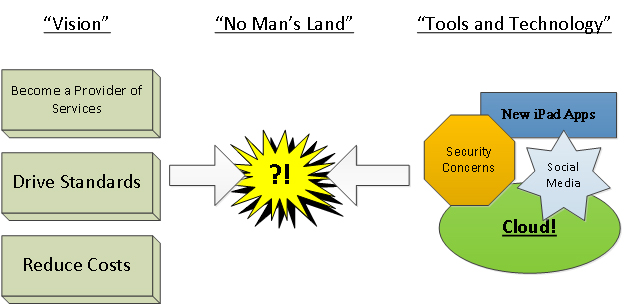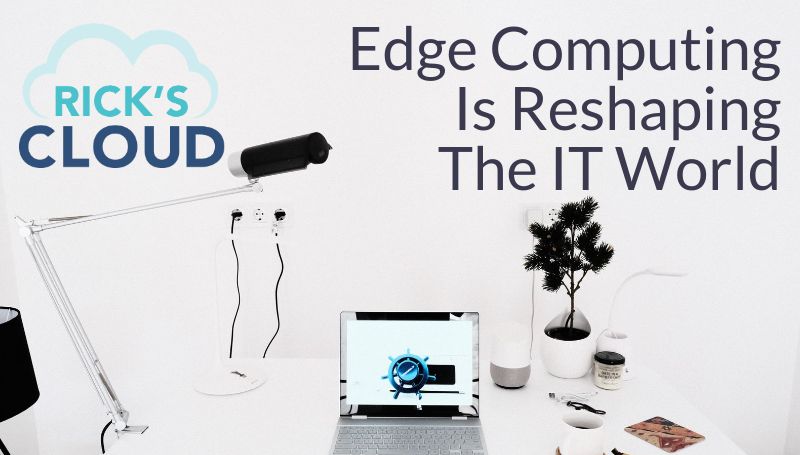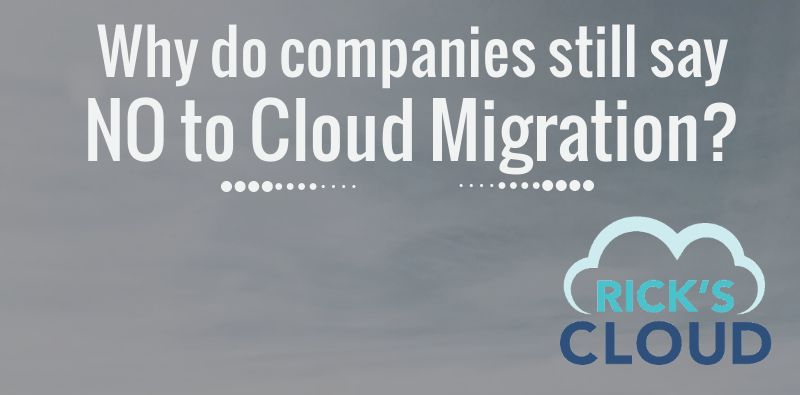
Translating a Vision for IT Amid a “Severe Storm Watch”
IT departments adopt technology from two perspectives: from a directive by the CIO to a “rogue IT” suggestion or project from an individual user. The former represents a top-down condition, while the latter has technology adoption from the bottom-up. Often times, there seems to be confusion somewhere in the middle, resulting in a smorgasbord of tools at one end, and a grand, ambitious strategy at the other end. This article suggests a framework to implement a vision from strategy, policy, process, and ultimately tools.
Vision for IT -> Strategies -> Policies -> Processes -> Procedures -> Tools and Automation
Revenue Generating Activities -> Business Process -> IT Services
As a solutions architect and consultant, I’ve met with many clients in the past few years. From director-level staff to engineers to support staff in the trenches, IT has taken on a language of its own. Every organization has its own acronyms, sure. Buzzwords and marketing hype strangle the English language inside the datacenter. Consider the range of experience present in many shops, and it is easy to imagine the confusion. The seasoned, senior executive talks about driving standards and reducing spend for datacenter floor space, and the excited young intern responds with telecommuting, tweets, and cloud computing, all in a proof-of-concept that is already in progress. What the…? Who’s right?

It occurred to me a while ago that there is a “severe storm watch” for IT. According to the National Weather Service, a “watch” is issued when conditions are favorable for [some type of weather chaos]. Well, in IT, more than in other departments, one can make these observations:
- Generationally-diverse workforce
- Diverse backgrounds of workers
- Highly variable experience of workers
- Rapidly changing products and offerings
- High complexity of subject matter and decisions
My colleague, Geoff Smith, recently posted a five-part series (The Taxonomy of IT) describing the operations of IT departments. In the series, Geoff points out that IT departments take on different shapes and behaviors based on a number of factors. The series presents a thoughtful classification of IT departments and how they develop, with a framework borrowed from biology. This post presents a somewhat more tactical suggestion on how IT departments can deal with strategy and technology adoption.
Yet Another Framework
A quick search on Google shows a load of articles on Business and IT Alignment. There’s even a Wikipedia article on the topic. I hear it all the time, and I hate the term. This term suggests that “IT” simply does the bidding of “The Business,” whatever that may be. I prefer to see Business and IT Partnership. But anyway, let’s begin with a partnership within IT departments. Starting with tools, do you know the value proposition of all of the tools in your environment? Do you know about all of the tools in your environment?

A single Vision for IT should first translate into one or more Strategies. I’m thinking of a Vision statement for IT that looks something like the following:
“Acme IT exists as a competitive, prime provider of information technology services to enable Acme Company to generate revenue by developing, marketing, and delivering its products and services to its customers. Acme IT stays competitive by providing Acme Company with relevant services that are delivered with the speed, quality and reliability that the company expects. Acme IT also acts as a technology thought leader for the company, proactively providing services that help Acme Company increase revenue, reduce costs, attract new customers, and improve brand image.”
Wow, that’s quite a vision for an IT department. How would a CIO begin to deliver on a vision like that? Just start using VMware, and you’re all set! Not quite! Installing VMware might come all the way at the end of the chain… at “Tool A” in the diagram above.
First, we need one or more Strategies. One valid Strategy may indeed be to leverage virtualization to improve time to market for IT services, and reduce infrastructure costs by reducing the number of devices in the datacenter. Great ideas, but a couple of Policies might be needed to implement this strategy.
One Policy, Policy A in the above diagram, might be that all application development should use a virtual server. Policy B might mandate that all new servers will be assessed as virtualization candidates before physical equipment is purchased.
Processes then flow from Policies. Since I have a policy that mandates that new development should happen on a virtual infrastructure, eventually I should be able to make a good estimate of the infrastructure needed for my development efforts. My Capacity Management process could then requisition and deploy some amount of infrastructure in the datacenter before it is requested by a developer. You’ll notice that this process, Capacity Management, enables a virtualization policy for developers, and neatly links up with my strategy to improve time to market for IT services (through reduced application development time). Eventually, we could trace this process back to our single Vision for IT.
But we’re not done! Processes need to be implemented by Procedures. In order to implement a capacity management process properly, I need to estimate demand from my customers. My customers will be application developers if we’re talking about the policy that developers must use virtualized equipment. Most enterprises have some sort of way to handle this, so we’d want to look at the procedure that developer customers use to request resources. To enable all of this, the request and the measurement of demand, I may want to implement some sort of Tool, like a service catalog or a request portal. That’s the end of the chain – the Tool.
Following the discussion back up to Vision, we can see how the selection of a tool is justified by following the chain back to procedure, process, policy, strategy, and ultimately vision.
This framework provides a simple alignment that can be used in IT departments for a number of advantages. One significant advantage is that it provides a common language for everyone in the IT department to understand the reasoning behind the design of a particular process, the need for a particular procedure, or the selection of a particular tool over another.
In a future blog post, I’ll cover the various other advantages of using this framework.
Food for Thought
- Do you see a proliferation of tools and a corresponding disconnect with strategy in your department?
- Who sets the vision and strategy for IT in your department?
- Is your IT department using a similar framework to rationalize tools?
- Do your IT policies link to processes and procedures?
- Can you measure compliance to your IT policies?
A guest post by John Dixon, from Journey to the Cloud.






IT Services
I’m impressed, I must say. Really rarely do I encounter a blog that’s both educative and entertaining, and let me tell you, https://www.rickscloud.com have hit the nail on the head. Your idea is outstanding; the issue is something that not enough people are speaking intelligently about. I am very happy that I stumbled across this in my search for something relating to this.
read more...
One more thing. It’s my opinion that there are a lot of travel insurance websites of respectable companies that allow you enter a trip details and acquire you the estimates. You can also purchase your international travel cover policy on the web by using your current credit card. All that you should do should be to enter your current travel information and you can be aware of the plans side-by-side. Just find the plan that suits your financial budget and needs and then use your bank credit card to buy the item. Travel insurance online is a good way to do investigation for a trustworthy company for international travel cover. Thanks for revealing your ideas.
Google
Google…
[…]usually posts some pretty intriguing stuff like this. If you are new to this site[…]…